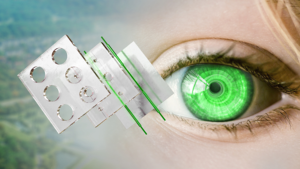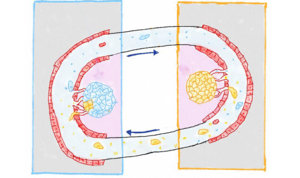Dutch Top Sector Life Sciences & Health selected seven projects for funding, aiming at developing ‘showcases’ of the potential of organ-on-a-chip systems. In three of them, the University of Twente is involved: in the ‘eye-on-a-chip’ project, in a chip for studying metastases and in a chip for finding better treatment of cardiovascular diseases.
An organ-on-a-chip is a fluidic system with micro channels, including a reservoir for living tissue. This miniature organ is fed using the channels, for mimicking a lifelike situation. In this way, the response of the cells on medication can be tested as well. The University of Twente has, in its MESA+ Institute and TechMed Centre, gained a lot experience in developing lab-on-a-chip and organ-on-a-chip systems. The university is part of the national ‘human Organ and Disease Model Technologies’ institute (hDMT).
EYE-ON-A-CHIP
 The PLURIMACULA-project will develop an organ-on-chip model of the outer part of the retina. Eighteen million people in Europe suffer from loss of sight or even blindness, caused by age-dependent macular degeneration. Worldwide this number grows to an estimated of 196 million people, causing 284 billion euros of medical costs. New preventive and curative treatments are more than necessary. For this, better knowledge of the disease, using lifelike models, is indispensable.
The PLURIMACULA-project will develop an organ-on-chip model of the outer part of the retina. Eighteen million people in Europe suffer from loss of sight or even blindness, caused by age-dependent macular degeneration. Worldwide this number grows to an estimated of 196 million people, causing 284 billion euros of medical costs. New preventive and curative treatments are more than necessary. For this, better knowledge of the disease, using lifelike models, is indispensable.
In age-dependent macular degeneration, the outer part of the retina is affected. The loss of sight starts with the inner circle of the eye. Retina tissue consists of various cell types, in multiple layers and connected through blood vessels. The researcher now want to mimic the intricate tissue in a microfluidic system. By using human stem cells for these, a personalized approach is possible.
At the end of the project, running for 18 months, the researchers expect to have a first prototype of a retina-on-a-chip. By then, they also have studied disease processes and experimented with several remedies.
The project brings together a consortium of engineers, stem cell biologistis, genetics and clinicians of the University of Twente, Leiden University Medical Centre, and Radboudumc. They will collaborate with Boehringer Ingelheim, a research-drive pharmaceutical company that relies on human material, not on lab animals. For this reason, the project also gets support from the Dutch Society for the Replacement of Animal Testing (Proefdiervrij).
HEART-ON-CHIP
The partners in this project are going to develop a heart-on-a-chip screening platform to identify new treatment options for cardiovascular diseases (CVD). They want to find ways of activating the lipoprotein lipase enzyme for his. Cardiovascular diseases are the number one causes of death, with 17,9 million deaths every year. People with a higher risk, are often treated with medication like statins, lowering cholesterol levels. Still, a large percentage cannot be treated yet.
Lipoprotein lipase recently had a lot of attention for its role in lipid metabolism, as a new ‘druggable target’ for lowering disease risks. Identifying small molecules that activate LPL is still eagerly awaited. Finding the these molecules is complex, as there is crosstalk between the endothelian cells and the metabolically active tissue. For this reason, a microfluidic chip will be developed in which the 3D heart tissue connects with a monolayer of endothelian cells on a micro channel. All will be based on human stem cells.
The moment this heart-on-a-chip model works, libraries of LPL-candidates can be tested as possible medication for CVD.
In this project, University of Twente collaborates with LUMC and River Biomedics.
CHIP-ME
 Cross-organ Human In-Vitro Platforms for Metastatic Environments
Cross-organ Human In-Vitro Platforms for Metastatic Environments
In what way does a tumor spread? The scientists of this project want to find an answer to this question by finding the way a tumor communicates with other organs.
Cancer is, especially when metastased, one of the most deadly disease. How tumors spread, is not well known yet, this complicates treatment research as well. A lot of research has focused on the growth of a tumor and the transformations taking place, but mechanical model describing their growth and further spreading are still lacking. The CHIP-ME consortium therefore wants to develop a modular and multi-organ platform, making use of microfluidic channels and vascularized mini-organs. How does a breast tumor interact with metastases in bone tissue, for example? CHIP-ME wants to culture several types of organoids, supply them with blood vessels, resulting in organ-specific modules. Following this, research will focus on the circulation between the organs, starting intermodular communication.
Based on knowledge of this communication, the researchers expert to find more targeted ways of treatment and to avoid ‘overtreatment’ of patients. Looking at the system as a whole is new: the multi-organ approach is expected to be the start of a whole new generation of organ-on-chip systems for clinical and industrial use, in prognosis and treatment evaluation.
In this project Universiteit Twente collaborates with UMCU, VyCap, Fluigent en BEOnChip.
Check Health~Holland's press release for more information





